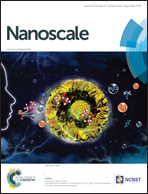Ultrastable polyethyleneimine-stabilized gold nanoparticles modified with polyethylene glycol for blood pool, lymph node and tumor CT imaging†
Abstract
Development of new long-circulating contrast agents for computed tomography (CT) imaging of different biological systems still remains a great challenge. Here, we report the design and synthesis of branched polyethyleneimine (PEI)-stabilized gold nanoparticles (Au PSNPs) modified with polyethylene glycol (PEG) for blood pool, lymph node, and tumor CT imaging. In this study, thiolated PEI was first synthesized and used as a stabilizing agent to form AuNPs. The formed Au PSNPs were then grafted with PEG monomethyl ether via PEI amine-enabled conjugation chemistry, followed by acetylation of the remaining PEI surface amines. The formed PEGylated Au PSNPs were characterized via different methods. We show that the PEGylated Au PSNPs with an Au core size of 5.1 nm have a relatively long half-decay time (7.8 h), and display a better X-ray attenuation property than conventionally used iodine-based CT contrast agents (e.g., Omnipaque), and are hemocompatible and cytocompatible in a given concentration range. These properties of the Au PSNPs afford their uses as a contrast agent for effective CT imaging of the blood pool and major organs of rats, lymph node of rabbits, and the xenografted tumor model of mice. Importantly, the PEGylated Au PSNPs could be excreted out of the body with time and also showed excellent in vivo stability. These findings suggest that the formed PEGylated Au PSNPs may be used as a promising contrast agent for CT imaging of different biological systems.


 Please wait while we load your content...
Please wait while we load your content...